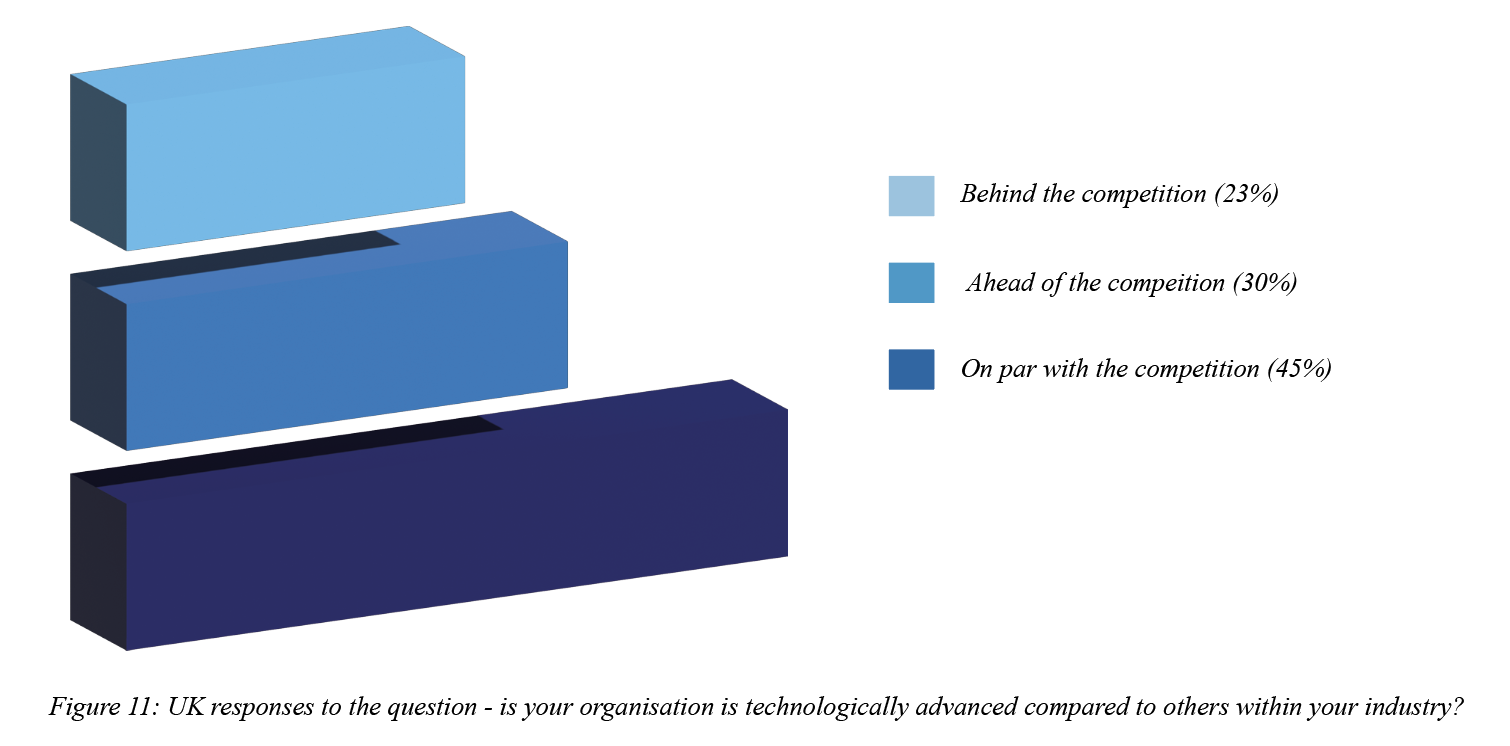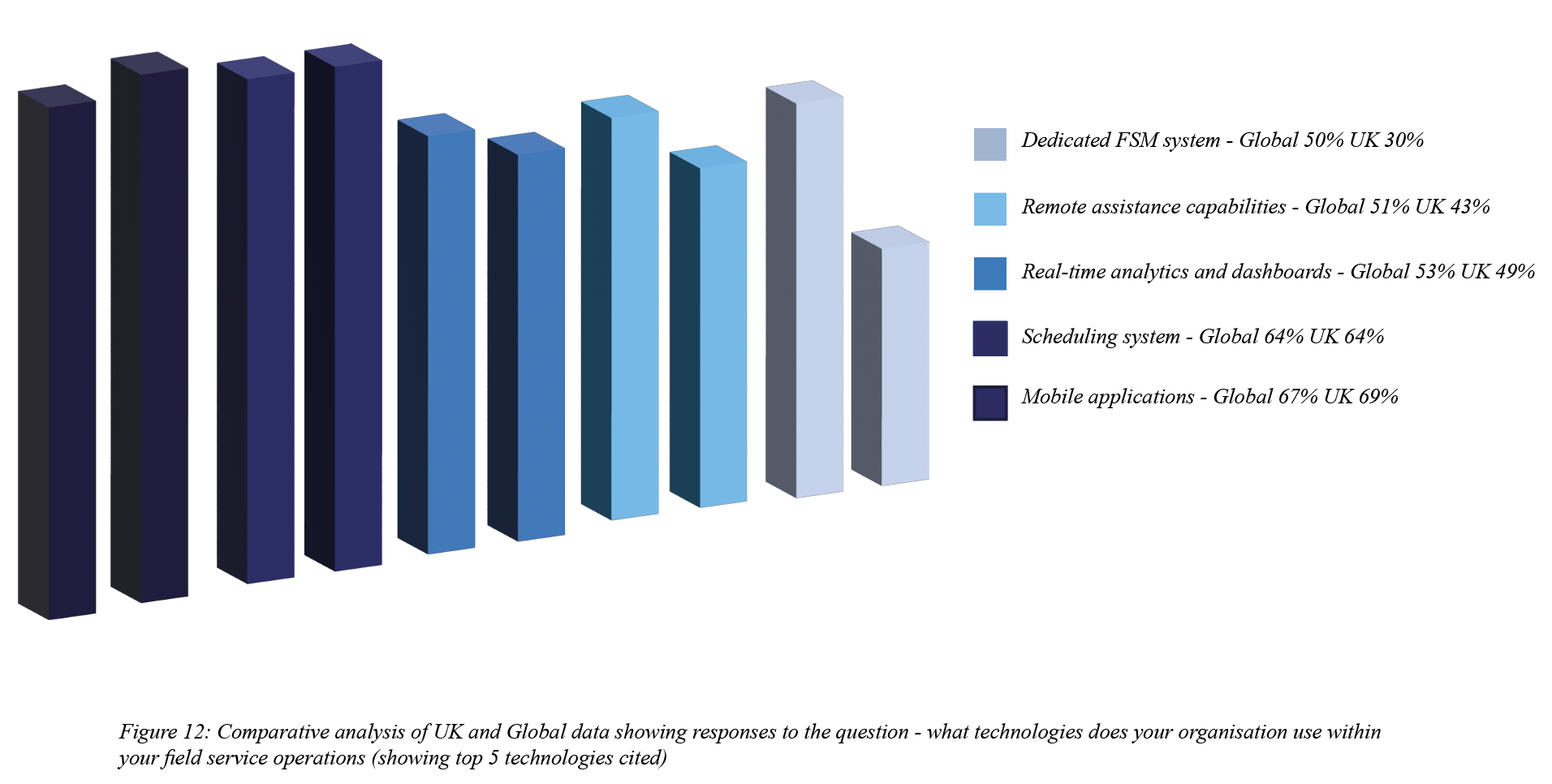Comparative Analysis: General perception of maturity of customer-centric driven technologies amongst field service companies
In the next in our series of comparative analyses across a global study and a follow-up UK study hosted by Field Service News Research in partnership with HSO, we look at how field service companies view their maturity compared to other markets and competitors.
Across the UK and global studies, we have seen widespread adoption of technologies and tools used by field service companies to drive customer satisfaction levels.
However, what is the industry sentiment with regards to the maturity of technology being used, and how will this differ as we offer up a comparative analysis between the global data and the UK based study?
In the next section of questions within the study, we focused on understanding how our respondents perceived the maturity of their technology adoption within their organisation and how they saw their industry verticals. The first question we asked was if our respondents would say their organisation is technologically advanced compared to others within their industry.
In the global study, the majority of companies (52%) saw themselves as being on par with most competitors. However, a third (33%) of companies felt they were ahead of their competition in this regard. In comparison, just over a tenth (13%) of companies thought they were behind their competition in terms of technology.
The UK data was overall slightly more balanced. 45% of companies felt that they were on par with the industry, 30% of companies stated they were ahead of the competition and 23% stated they felt they were behind the competition. (Fig 11. Below)

We also asked our respondents if they felt that their industry was technologically advanced compared to other service-focused industries. Here, on the industry level, we saw even greater confidence in the maturity of technology amongst the global respondents, with over half of the respondents (51%) stating that they felt their industry was technologically advanced compared to just under a quarter (24%) of companies saying that they felt their industry was about average in terms of technology adoption. A similar amount (23%) felt that their industry was behind other sectors.
In this regard, there was less underlying confidence amongst the UK respondents although again it was a more balanced response. 38% of UK field service companies felt that the industry they operated in was more technologically advanced than others, while 35% stated their industry was behind others and 24% stated they felt their industry was about average in terms of technology adoption.
But how does this perception of UK companies compare to the reality?
When we look at the core technologies employed for field service management, there appeared to be a baseline maturity of technology adoption amongst field service organisations participating in the global study.
The following technologies were being used by at least half of all field service companies within the global study; Mobile applications (65%), Scheduling Systems (64%), Real-time analytics and dashboards (53%), Remote assistance capabilities (51%), Dedicated FSM system (50%).
Meanwhile, let us look at the comparative responses from UK field service companies: Mobile applications (67% +2% on global), Scheduling Systems (64% equal to global study), Real-time analytics and dashboards (49% – down 4% on the global study), Remote assistance capabilities (43% down 8% on the global study), Dedicated FSM system (30% down 20% on the global study). (Fig 12. Below)

These findings would seem to corroborate the sentiment we discovered in the responses to the previous question. UK companies appear to have less technological adoption than those in the global study. Of course, for a more detailed analysis, we would need to conduct more comparative studies, but the raw indication from these two studies would certainly indicate that this is the case.
This finding is particularly interesting as the UK is often regarded as a mature market in terms of field service technology adoption. However, counterintuitively, such maturity could be an indicator as to why we see the UK lagging behind in terms of technology adoption across the two studies that have a combined response group of over 500 field service leaders.
Could it be that UK field service companies’ reliance on legacy systems be why we see such a discrepancy? Similarly, could it be that we see the maturity of field service in the UK as a factor that makes it harder for such companies to react as fast , which in a time of accelerated digital transformation could see them move from leading edge to laggard?
Even still, the findings of both studies do reveal a prevalence of technologies within the field service sector. Both studies findings appear to corroborate what many in the field service sector have believed for some time – we are now approaching a point of widespread adoption of fundamental technologies.
In our first report, we stated that we believed the investment in technology has now moved beyond the first iteration of evolution in our sector and into a new wave of technological advancement.
If this is the case, this would dovetail with the idea that the more mature markets would see slower acceleration of digital transformation. However, we could also be seeing the result of additional layers of complexity into the UK working environment caused by Brexit at play as well and hampering the rapid development and implementation of technology we are seeing elsewhere.
In the following section of this report, we shall turn our attention to digital transformation trends, which may give us further insight.
In the next feature in this series we shall turn our attention to digital transformation trends, which may give us further insight.
Want to know more and don’t want to wait? Field Service News subscribers can access the full 20 page comparative analysis report on the button at the top of this article.
This Field Service News Research study is sponsored by HSO

This content is available exclusively for FSN Premium members. Please either log-in or subscribe for access
 Data usage note: By accessing this content you consent to the contact details submitted when you registered as a subscriber to fieldservicenews.com to be shared with the listed sponsor of this premium content HSO who may contact you for legitimate business reasons to discuss the content of this white paper.
Data usage note: By accessing this content you consent to the contact details submitted when you registered as a subscriber to fieldservicenews.com to be shared with the listed sponsor of this premium content HSO who may contact you for legitimate business reasons to discuss the content of this white paper.


